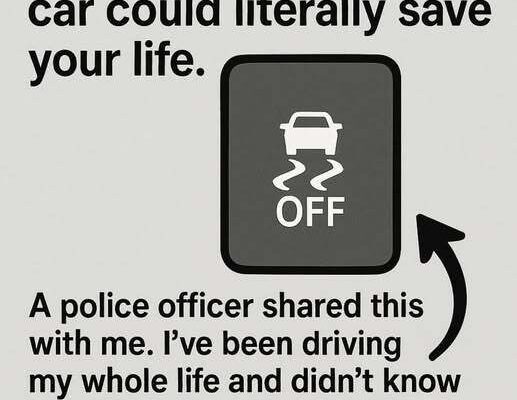Most of us spend years behind the wheel without ever learning what every button, switch, or symbol on the dashboard actually does. We know the basics, of course — headlights, wipers, turn signals — but modern cars include safety features that many drivers never fully explore. One of the most overlooked is the switch shown in the image: the Traction Control System (TCS) or Electronic Stability Control (ESC) button.
A police officer once explained its purpose to a driver who had gone decades without realizing what it did, and many people share the same experience. Whether you’ve been driving for two years or fifty, understanding this feature could help you stay safer on the road, especially during unexpected driving conditions.
Let’s break down what this switch does, when you should leave it on, and those rare moments when turning it off might actually help.
What This Button Actually Controls
The icon in the image — a car with squiggly lines beneath it — represents your vehicle’s traction control or stability control system. While the wording may differ slightly depending on your car’s make and model, the purpose is the same:
to help your vehicle maintain grip on the road.
When the system is on, it automatically senses when one or more wheels are slipping. The car then responds by:
- Gently reducing engine power
- Applying braking to specific wheels
- Helping the vehicle straighten out if it begins to skid
In everyday terms, traction control helps prevent the car from fishtailing, sliding, or losing control on wet, icy, sandy, or loose surfaces.
Most cars have this feature turned on by default, and for good reason. In normal driving conditions, it can make a tremendous difference in keeping your vehicle stable.
Why Leaving It On Can Help Save Lives
Traction control and stability systems are among the most important safety technologies added to modern vehicles. Studies have shown they can significantly reduce the risk of accidents, especially in bad weather or during sudden evasive maneuvers.
Here’s why:
- Rainy roads become less hazardous since the system stops your tires from spinning too quickly.
- Icy patches that used to cause dangerous slides are managed by automatic braking adjustments.
- Sharp curves or sudden swerves are easier to control, as the system helps keep the car pointed in the right direction.
In many cases, drivers never even notice the system activating — but it’s working silently in the background to keep them safe.
For older adults, those with slower reaction times, or anyone who wants added protection, this feature offers an invaluable layer of support.
But Why Have an “OFF” Switch?
If this safety feature is so important, why would manufacturers include a way to turn it off?
It turns out, there are a few specific situations where disabling traction control can actually help:
1. Getting your car unstuck
If your vehicle is trapped in deep snow, thick mud, or sand, the traction control may keep engine power too low for you to break free. Turning it off allows the wheels to spin harder and gives you a better chance of rocking the car out.
2. Driving up a slippery hill
Sometimes you need a bit more wheel spin to climb through snow or loose gravel. With traction control on, the system may reduce power at the exact moment you need it most.
3. Performance driving
For everyday drivers, this one doesn’t apply, but on closed tracks, experienced drivers sometimes disable traction control for better maneuverability.
Outside of these situations, the safest choice is to keep the system on at all times.
Why So Many Drivers Don’t Know About It
This feature became more common in vehicles during the late 1990s and early 2000s, but many people who learned to drive before then never had a car equipped with it. Because most cars leave the system on by default, many drivers have never pressed the button or looked closely at the symbol.
Some may have mistakenly thought the icon meant the car was slippery, or that it related to tire pressure. Others may have seen the light activate during a skid without understanding why.
When a police officer explains it, as mentioned in the image, drivers often say the exact same thing:
“I’ve been driving my whole life and never knew that!”
What Every Driver Should Remember
To keep things simple:
- Leave traction control ON for everyday driving.
- Turn it OFF only if you’re stuck in snow, mud, or sand.
- If the warning light stays on constantly, have your system checked.
- If it flashes while driving, that means it’s actively helping — not malfunctioning.
Understanding this one button can help you drive more confidently, especially during unpredictable conditions.
It’s a small symbol on the dashboard, but it’s a powerful reminder of how far vehicle safety technology has come — and how much it can do to protect you when you need it most.
If you haven’t looked closely at this feature before, now is the perfect time to understand how it works. It may be a simple button, but knowing how to use it wisely truly can make a difference on the road.




